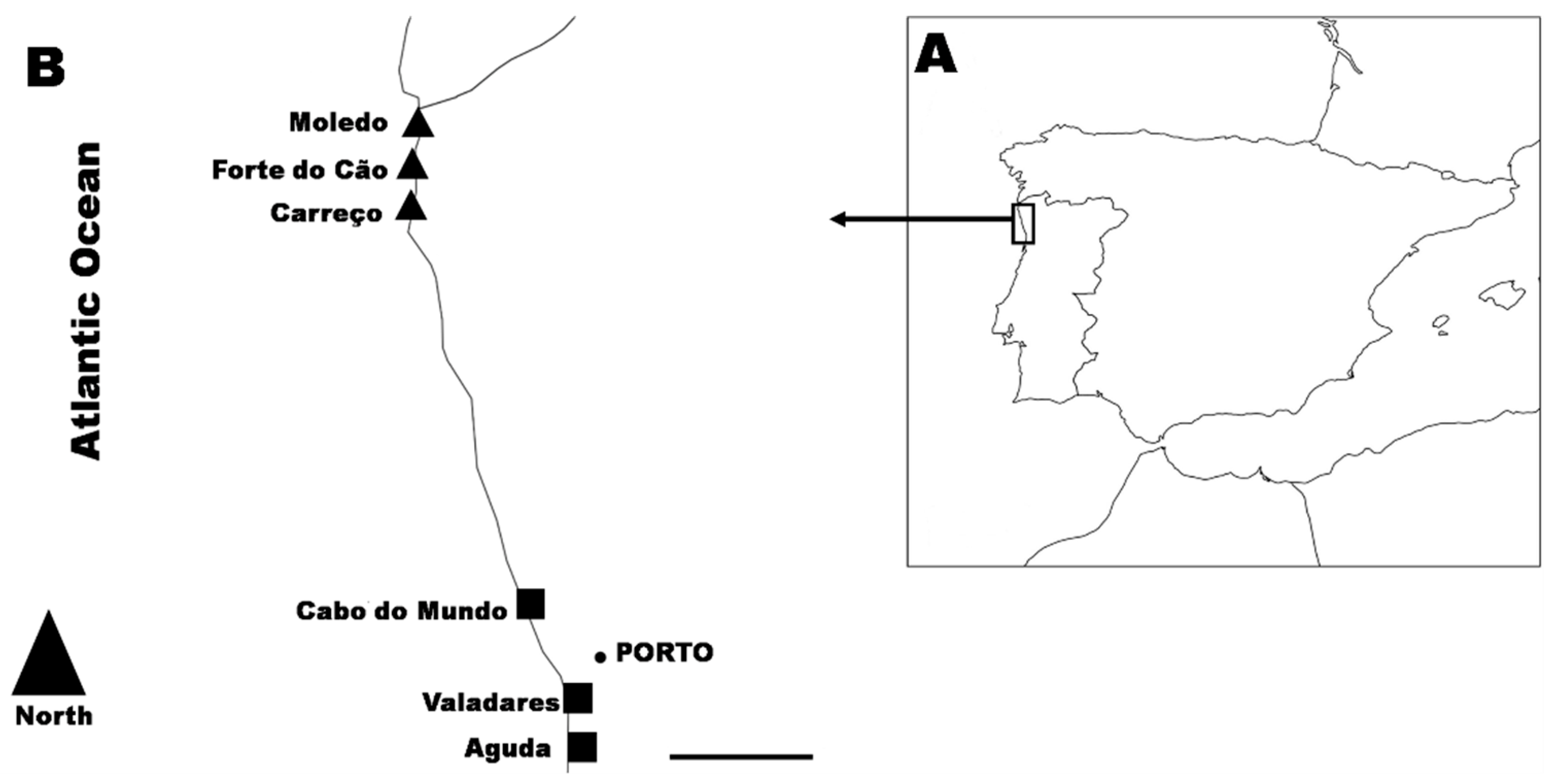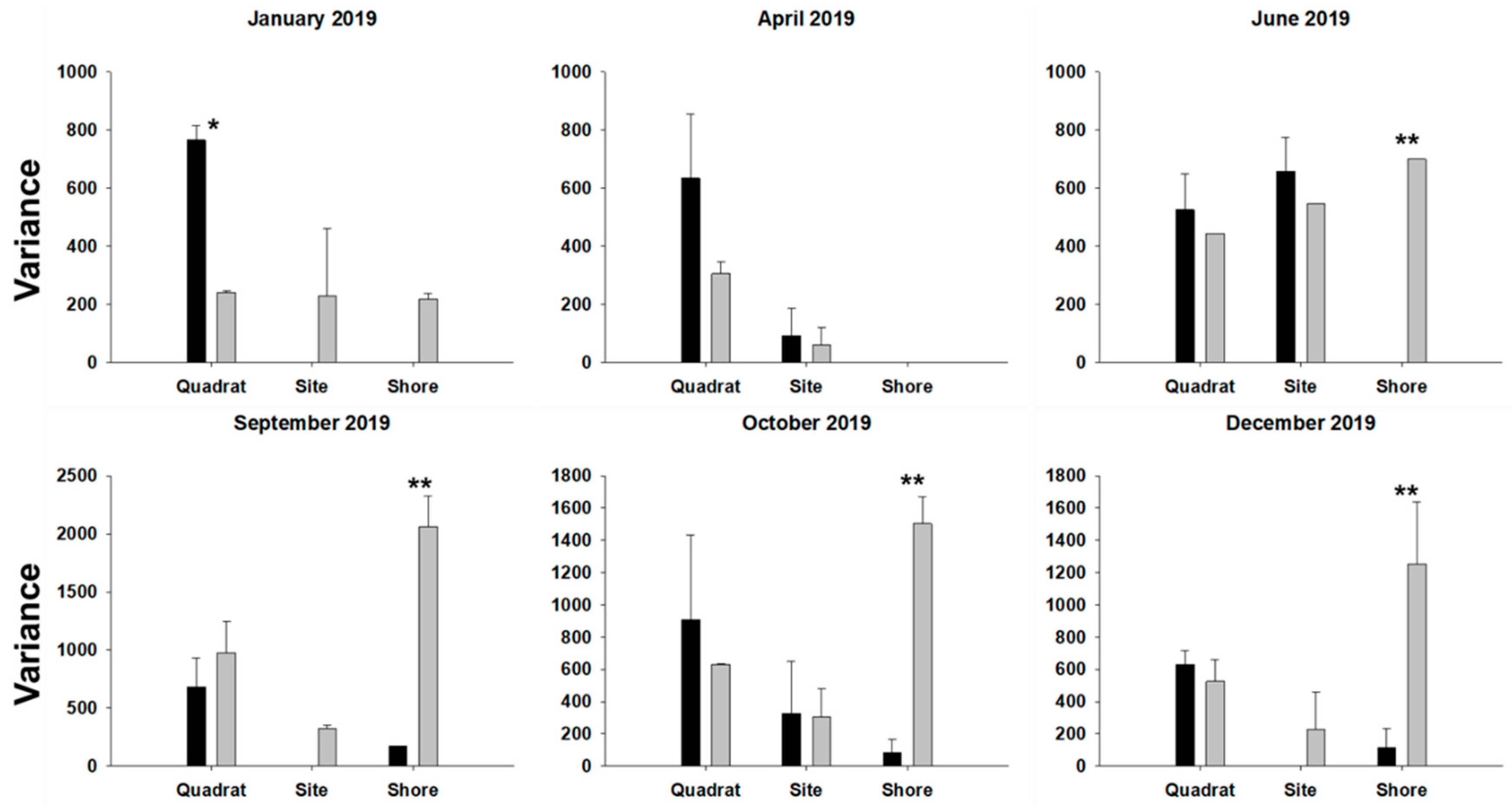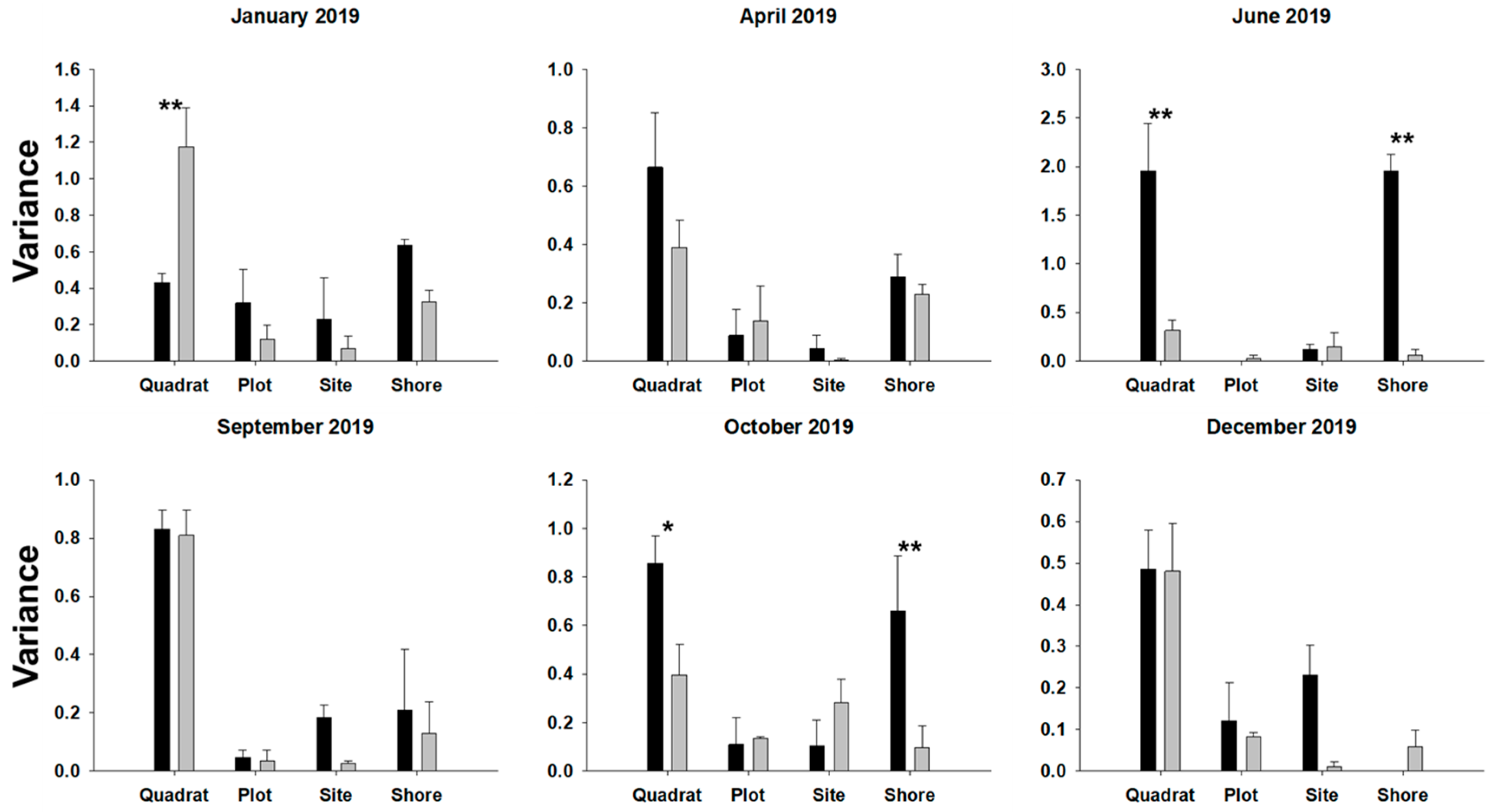Influence of Urbanization on Patterns of Variability of Mytilus galloprovincialis Populations
Abstract
:1. Introduction
2. Materials and Methods
2.1. Study Area
2.2. Sample Collection and Processing
2.3. Data Analyses
3. Results
4. Discussion
5. Conclusions
Supplementary Materials
Author Contributions
Funding
Institutional Review Board Statement
Informed Consent Statement
Data Availability Statement
Acknowledgments
Conflicts of Interest
References
- Boaventura, D.; Ré, P.; Fonseca, L.C.; Hawkins, S.J. Intertidal rocky shore communities of the continental Portuguese coast: Analyses of distribution patterns. Mar. Ecol. 2002, 23, 69–90. [Google Scholar] [CrossRef]
- Ramos-Oliveira, C.; Sampaio, L.; Rubal, M.; Veiga, P. Spatial-temporal variability of Mytilus galloprovincialis Lamarck 1819 populations and their accumulated sediment in northern Portugal. PeerJ 2021, 9, e11499. [Google Scholar] [CrossRef]
- Coelho, S.D.; Vieira, H.C.; Oliveira, J.M.M.; Pires, S.F.S.; Rocha, R.J.M.; Rodrigues, A.C.M.; Soares, A.M.V.M.; Bordalo, M.D. How does Mytilus galloprovincialis respond when exposed to the gametophyte phase of the invasive red macroalga Asparagopsis armata exudate? Water 2021, 13, 460. [Google Scholar] [CrossRef]
- Musella, M.; Wathsala, R.; Tavella, T.; Rampelli, S.; Barone, M.; Palladino, G.; Biagi, E.; Brigidi, P.; Turroni, S.; Franzellitti, S.; et al. Tissue-scale microbiota of the Mediterranean mussel (Mytilus galloprovincialis) and its relationship with the environment. Sci. Total Environ. 2020, 717, 137209. [Google Scholar] [CrossRef]
- Arribas, L.P.; Donnarumma, L.; Palomo, M.G.; Scrosati, A. Intertidal mussels as ecosystem engineers: Their associated invertebrate biodiversity under contrasting wave exposures. Mar. Biodivers. 2014, 44, 203–211. [Google Scholar] [CrossRef]
- Torres, A.C.; Rubal, M.; Costa-Garcia, R.; Sousa-Pinto, I.; Veiga, P. Differences in the structure and diversity of invertebrate assemblages harbored by an intertidal ecosystem engineer between urban and non-urban shores. J. Mar. Sci. Eng. 2022, 10, 242. [Google Scholar] [CrossRef]
- Kautsky, N.; Evans, S. Role of biodeposition by Mytilus edulis in the circulation of matter and nutrients in a Baltic coastal ecosystem. Mar. Ecol. Prog. Ser. 1987, 38, 201–212. [Google Scholar] [CrossRef]
- Gestoso, I.; Arenas, F.; Rubal, M.; Veiga, P.; Peña, M.; Olabarria, C. Shifts from native to non-indigenous mussels: Enhanced habitat complexity and its effects on faunal assemblages. Mar. Environ. Res. 2013, 90, 85–95. [Google Scholar] [CrossRef]
- Rius, M.; Cabral, H.N. Human harvesting of Mytilus galloprovincialis Lamarck, 1819, on the central coast of Portugal. Sci. Mar. 2004, 68, 545–551. [Google Scholar] [CrossRef] [Green Version]
- Avdelas, L.; Avdic-Mravlje, E.; Borges Marques, A.C.; Cano, S.; Capelle, J.J.; Carvalho, N.; Cozzolino, M.; Dennis, J.; Ellis, T.; Fernández Polanco, J.M.; et al. The decline of mussel aquaculture in the European Union: Causes, economic impacts and opportunities. Rev. Aquac. 2021, 13, 91–118. [Google Scholar] [CrossRef]
- Hawkins, S.J.; Pack, K.E.; Hyder, K.; Benedetti-Cecchi, L.; Jenkins, S.R. Rocky shores as tractable test systems for experimental ecology. J. Mar. Biol. Assoc. UK 2020, 100, 1017–1041. [Google Scholar] [CrossRef]
- Thompson, R.C.; Crowe, T.P.; Hawkins, S.J. Rocky intertidal communities: Past environmental changes, present status and predictions for the next 25 years. Environ. Conserv. 2002, 29, 168–191. [Google Scholar] [CrossRef]
- Kunze, C.; Wölfelschneider, M.; Rölfer, L. Multiple driver impacts on rocky intertidal systems: The need for an integrated approach. Front. Mar. Sci. 2021, 8, 667168. [Google Scholar] [CrossRef]
- Crowe, T.P.; Thompson, R.C.; Bray, S.; Hawkins, S.J. Impacts of anthropogenic stress on rocky intertidal communities. J. Aquat. Ecosyst. Stress Recovery 2000, 7, 273–297. [Google Scholar] [CrossRef]
- Underwood, A.J. The mechanisms of spatially replicated sampling programmes to detect environmental impact in a variable world. Aust. J. Ecol. 1993, 18, 99–116. [Google Scholar] [CrossRef]
- Tsikopoulou, I.; Dimitriou, P.D.; Karakassis, I.; Lampadariou, N.; Papadopoulou, N.; Smith, C.J. Temporal variation in the ecological functioning of benthic communities after 20 years in the Eastern Mediterranean. Front. Mar. Sci. 2021, 8, 768051. [Google Scholar] [CrossRef]
- Balata, D.; Bertocci, I.; Piazzi, L.; Nesti, U. Comparison between epiphyte assemblages of leaves and rhizomes of the seagrass Posidonia oceanica subjected to different levels of anthropogenic eutrophication. Estuar. Coast. Shelf Sci. 2008, 79, 533–540. [Google Scholar] [CrossRef]
- Oliveira, J.P.; Sousa-Pinto, I.; Weber, G.M.; Bertocci, I. Urban vs. extra-urban environments: Scales of variation of intertidal benthic assemblages in north Portugal. Mar. Environ. Res. 2014, 97, 48–57. [Google Scholar] [CrossRef]
- Bertocci, I.; Arenas, F.; Cacabelos, E.; Martins, G.M.; Seabra, M.I.; Álvaro, N.V.; Fernandes, J.N.; Gaião, R.; Mamede, N.; Mulas, M.; et al. Nowhere safe? Exploring the influence of urbanization across mainland and insular seashores in continental Portugal and the Azorean Archipelago. Mar. Pollut. Bull. 2017, 114, 644–655. [Google Scholar] [CrossRef]
- Bishop, M.J.; Underwood, A.J.; Archambault, P. Sewage and environmental impact on rocky shores: Necessity of identifying relevant spatial scales. Mar. Ecol. Prog. Ser. 2002, 236, 121–128. [Google Scholar] [CrossRef] [Green Version]
- Morrisey, D.J.; Howitt, L.; Underwood, A.J.; Stark, J.S. Spatial variation in soft sediment benthos. Mar. Ecol. Prog. Ser. 1992, 81, 197–204. [Google Scholar] [CrossRef]
- Hewitt, J.E.; Thrush, S.F. Do species’ abundance become more spatially variable with stress? Open J. Ecol. 2009, 2, 37–46. [Google Scholar] [CrossRef] [Green Version]
- Barragan, J.M.; de Andrés, M. Analysis and trends of the world’s coastal cities and agglomerations. Ocean Coast. Manag. 2015, 114, 11–20. [Google Scholar] [CrossRef]
- Todd, P.A.; Heery, E.C.; Loke, L.H.L.; Thurstan, R.H.; Kotze, D.J.; Swan, C. Towards an urban marine ecology: Characterizing the drivers, patterns and processes of marine ecosystems in coastal cities. Oikos 2019, 128, 1215–1242. [Google Scholar] [CrossRef] [Green Version]
- Momota, K.; Hosokawa, S. Potential impacts of marine urbanization on benthic macrofaunal diversity. Sci. Rep. 2021, 11, 4028. [Google Scholar] [CrossRef]
- Mayer-Pinto, M.; Cole, V.J.; Johnston, E.L.; Bugnot, A.; Hurst, H.; Airoldi, L.; Glasby, T.M.; Dafforn, K.A. Functional and structural responses to marine urbanisation. Environ. Res. Lett. 2018, 13, 014009. [Google Scholar] [CrossRef]
- Airoldi, L.; Bulleri, F. Anthropogenic disturbance can determine the magnitude of opportunistic species responses on marine urban infrastructures. PLoS ONE 2010, 6, e22985. [Google Scholar] [CrossRef] [Green Version]
- Bulleri, F. Is it time for urban ecology to include the marine realm? Trends Ecol. Evol. 2006, 21, 658–659. [Google Scholar] [CrossRef]
- Airoldi, L.; Beck, M.W. Loss, status and trends for coastal marine habitats of Europe. Oceanogr. Mar. Biol. Annu. Rev. 2007, 45, 345–405. [Google Scholar]
- Smith, J.R.; Murray, S.N. The effects of experimental bait collection and trampling on a Mytilus californianus mussel bed in southern California. Mar. Biol. 2005, 147, 699–706. [Google Scholar] [CrossRef]
- Carranza, A.; Defeo, O.; Beck, M.; Castilla, J.C. Linking fisheries management and conservation in bioengineering species: The case of South American mussels (Mytilidae). Rev. Fish Biol. Fish. 2009, 19, 349–366. [Google Scholar] [CrossRef] [Green Version]
- Crain, C.M.; Kroeker, K.; Halpern, B.S. Interactive and cumulative effects of multiple human stressors in marine systems. Ecol. Lett. 2008, 11, 1304–1315. [Google Scholar] [CrossRef] [PubMed]
- Rubal, M.; Veiga, P.; Reis, P.A.; Bertocci, I.; Sousa-Pinto, I. Effects of subtle pollution at different levels of biological organisation on species-rich assemblages. Environ. Pollut. 2014, 191, 101–110. [Google Scholar] [CrossRef] [PubMed]
- Reis, P.A.; Cassiano, J.; Veiga, P.; Rubal, M.; Sousa-Pinto, I. Fucus spiralis as monitoring tool of metal contamination in the northwest coast of Portugal under the European Water Framework Directives. Environ. Monit. Assess. 2014, 186, 5447–5460. [Google Scholar] [CrossRef]
- Dias, J.M.A.; Gonzalez, R.; Garcia, C.; Diaz-del Rio, V. Sediment distribution patterns on the Galicia-Minho continental shelf. Prog. Oceanogr. 2002, 52, 215–231. [Google Scholar] [CrossRef]
- Veiga, P.; Rubal, M.; Vieira, R.; Arenas, F.; Sousa-Pinto, I. Spatial variability in intertidal macroalgal assemblages on the North Portuguese coast. Consistence between species and functional groups approaches. Helgol. Mar. Res. 2013, 67, 191–201. [Google Scholar] [CrossRef] [Green Version]
- Lemos, R.T.; Pires, H.O. The upwelling regime off the west Portuguese coast, 1941–2000. Int. J. Climatol. 2004, 24, 511–515. [Google Scholar] [CrossRef]
- Veiga, P.; Ramos-Oliveira, C.; Sampaio, L.; Rubal, M. The role of urbanisation in affecting Mytilus galloprovincialis. PLoS ONE 2020, 15, e0232797. [Google Scholar] [CrossRef]
- Dethier, M.N.; Graham, E.S.; Cohen, S.; Tear, L.M. Visual versus random-point percent cover estimations: “Objective” is not always better. Mar. Ecol. Prog. Ser. 1993, 96, 93–100. [Google Scholar] [CrossRef]
- Underwood, A.J. Experiments in Ecology: Their Logical Design and Interpretation Using Analysis of Variances, 2nd ed.; Cambridge University Press: Cambridge, UK, 1997. [Google Scholar]
- Fletcher, D.J.; Underwood, A.J. How to cope with negative estimates of components of variance in ecological field studies. J. Exp. Mar. Biol. Ecol. 2002, 273, 89–95. [Google Scholar] [CrossRef]
- Warwick, R.M.; Clarke, K.R. Increased variability as a symptom of stress in marine communities. J. Exp. Mar. Biol. Ecol. 1993, 172, 215–226. [Google Scholar] [CrossRef]
- Hewitt, J.; Thrush, S.; Lohrer, A.; Townsend, M. A latent threat to biodiversity: Consequences of small-scale heterogeneity loss. Biodivers. Conserv. 2010, 19, 1315–1323. [Google Scholar] [CrossRef]
- Olden, J.D.; Rooney, T.P. On defining and quantifying biotic homogenization. Glob. Ecol. Biogeogr. 2006, 15, 113–120. [Google Scholar] [CrossRef]
- Martins, C.D.L.; Arantes, N.; Faveri, C.; Batista, M.B.; Oliveira, E.C.; Pagliosa, P.R.; Fonseca, A.L.; Nunes, J.M.C.; Chow, F.; Pereira, S.B.; et al. The impact of coastal urbanization on the structure of phytobenthic communities in southern Brazil. Mar. Pollut. Bull. 2012, 64, 772–778. [Google Scholar] [CrossRef] [PubMed]
- Bahartan, K.; Zibdah, M.; Ahmed, Y.; Israel, A.; Brickner, I.; Abelson, A. Macroalgae in the coral reefs of Eilat (Gulf of Aqaba, Red Sea) as a possible indicator of reef degradation. Mar. Pollut. Bull. 2010, 60, 759–764. [Google Scholar] [CrossRef] [PubMed]
- Taylor, L.R. Aggregation, variance and the mean. Nature 1961, 189, 732–735. [Google Scholar] [CrossRef]
- Okumus, I.; Stirling, H.P. Seasonal variations in the meat weight, condition index and biochemical composition of mussels (Mytilus edulis L.) in suspended culture in two Scottish sea lochs. Aquaculture 1998, 159, 249–261. [Google Scholar] [CrossRef]
- Çelik, M.Y.; Karayücel, S.; Karayücel, I.; Öztürk, R.; Eyüboglu, B. Meat yield, condition index and biochemical composition of mussels (Mytilus galloprovincialis Lamarck, 1819) in Sinop, South of the Black Sea. J. Aquat. Food Prod. Technol. 2012, 21, 198–205. [Google Scholar] [CrossRef]
- Puccinelli, E.; Noyon, M.; McQuaid, C.D. Does proximity to urban centres affect the dietary regime of marine benthic filter feeders? Estuar. Coast. Shelf Sci. 2016, 169, 147–157. [Google Scholar] [CrossRef]
- Zardi, G.I.; McQuaid, C.D.; Nicastro, K.R. Balancing survival and reproduction: Seasonality of wave action, attachment strength and reproductive output in indigenous Perna perna and invasive Mytilus galloprovincialis mussels. Mar. Ecol. Prog. Ser. 2007, 334, 155–163. [Google Scholar] [CrossRef]
- Zardi, G.I.; Nicastro, K.R.; McQuaid, C.D.; Rius, M.; Porri, F. Hydrodynamic stress and habitat partitioning between indigenous (Perna perna) and invasive (Mytilus galloprovincialis) mussels: Constraints of an evolutionary strategy. Mar. Biol. 2006, 150, 79–88. [Google Scholar] [CrossRef]
- Oliveira, J.P.; Sousa-Pinto, I.; Weber, G.M.; Bertocci, I. Interplay of experimental harvesting and climate-related disturbance on benthic assemblages of rocky sea shores. Mar. Ecol. Prog. Ser. 2014, 495, 131–142. [Google Scholar] [CrossRef] [Green Version]
- Chapman, M.G.; Underwood, A.J.; Skilleter, G.A. Variability at different spatial scales between a subtidal assemblage exposed to the discharge of sewage and two control assemblages. J. Exp. Mar. Biol. Ecol. 1995, 189, 103–122. [Google Scholar] [CrossRef]
- Gomes, I.; Peteiro, L.; Bueno-Pardo, J.; Albuquerque, R.; Pérez-Jorge, S.; Oliveira, E.R.; Alves, F.L.; Queiroga, H. What’s a picture really worth? On the use of drone aerial imagery to estimate intertidal rocky shore mussel demographic parameters. Estuar. Coast. Shelf Sci. 2018, 213, 185–198. [Google Scholar] [CrossRef]
- Fraschetti, S.; Terlizzi, A.; Benedetti-Cecchi, L. Patterns of distribution of marine assemblages from rocky shores: Evidence of relevant scales of variation. Mar. Ecol. Prog. Ser. 2005, 296, 13–29. [Google Scholar] [CrossRef] [Green Version]
- Legendre, P.; Thrush, S.F.; Cummings, V.J.; Dayton, P.K.; Grant, J.; Hewitt, J.E.; Hines, A.H.; McArdle, B.H.; Pridmore, R.D.; Schneider, D.C.; et al. Spatial structure of bivalves in a sandflat: Scale and generating processes. J. Exp. Mar. Biol. Ecol. 1997, 216, 99–128. [Google Scholar] [CrossRef]
- Benedetti-Cecchi, L.; Bulleri, F.; Acunto, S.; Cinelli, F. Scales of variation in the effects of limpets on rocky shores in the northwest Mediterranean. Mar. Ecol. Prog. Ser. 2001, 209, 131–141. [Google Scholar] [CrossRef] [Green Version]
- Coleman, M.A. Small-scale spatial variability in intertidal and subtidal turfing algal assemblages and the temporal generality of these patterns. J. Exp. Mar. Biol. Ecol. 2002, 267, 53–74. [Google Scholar] [CrossRef]
- Tuya, F.; Haroun, R.J. Spatial patterns and response to wave exposure of shallow water algal assemblages across the Canarian archipelago: A multi-scaled approach. Mar. Ecol. Prog. Ser. 2006, 311, 15–28. [Google Scholar] [CrossRef]
- Araújo, R.; Vaselli, S.; Almeida, M.; Serrão, E.; Sousa-Pinto, I. Effects of disturbance on marginal populations: Human trampling on Ascophyllum nodosum assemblages at its southern distribution limit. Mar. Ecol. Prog. Ser. 2009, 378, 81–92. [Google Scholar] [CrossRef] [Green Version]
- Rubal, M.; Torres, A.C.; Veiga, P. Low diversity of intertidal canopy-forming macroalgae at urbanized areas along the North Portuguese coast. Diversity 2020, 12, 211. [Google Scholar] [CrossRef]
- Baden, S.; Hernroth, B.; Lindahl, O. Declining popularions of Mytilus spp. In north Atlantic coastal waters-A Swedish perspective. J. Shellfish Res. 2021, 40, 269–296. [Google Scholar] [CrossRef]





| Source of Variation | df | Cover | Total Density | Spat Density | |||
|---|---|---|---|---|---|---|---|
| MS | F | MS | F | MS | F | ||
| Condition (Co) | 1 | 3456.37 | 1.66 | 1,387,337.64 | 3.91 | 458,779.65 | 2.67 |
| Scale (Sc) | 2 | 18,846.57 | 3.00 | 883,172.35 | 3.57 | 138,364.76 | 1.56 |
| Date (Da) | 5 | 5607.86 | 1.45 | 497,718.77 | 9.09 *** | 159,094.97 | 4.96 ** |
| Co × Sc | 2 | 4863.73 | 0.65 | 1,822,685.00 | 12.99 *** | 269,158.69 | 5.82 * |
| Co × Da | 5 | 2077.76 | 0.54 | 354,896.74 | 6.48 *** | 171,718.28 | 5.36 *** |
| Sc × Da | 10 | 6274.56 | 1.62 | 247,048.18 | 4.51 *** | 88,666.11 | 2.77 * |
| Co × Sc × Da | 10 | 7443.19 | 1.92 | 140,352.82 | 2.56 * | 46,268.34 | 1.44 |
| Residual | 36 | 3875.38 | 54,741.74 | 32,050.96 | |||
| Total | 71 | ||||||
| Transformation | none | Square root | Square root | ||||
| Cochran’s test | C = 0.22 | ns | C = 0.28 | ns | C = 0.19 | ns | |
| Source of Variation | df | Thickness | Condition Index | Shell Length | |||
|---|---|---|---|---|---|---|---|
| MS | F | MS | F | MS | F | ||
| Condition (Co) | 1 | 1.05 | 2.38 | 2.20 | 0.83 | 0.01 | 1.41 |
| Scale (Sc) | 3 | 2.08 | 14.99 *** | 82.48 | 27.66 *** | 0.77 | 45.84 *** |
| Date (Da) | 5 | 0.32 | 10.02 *** | 5.84 | 8.70 *** | 0.02 | 11.18 *** |
| Co × Sc | 3 | 0.26 | 1.06 | 1.96 | 3.16 | 0.003 | 1.33 |
| Co × Da | 5 | 0.44 | 13.87 *** | 2.64 | 3.93 ** | 0.01 | 4.54 ** |
| Sc × Da | 15 | 0.14 | 4.38 *** | 2.98 | 4.44 *** | 0.02 | 12.30 *** |
| Co × Sc × Da | 15 | 0.25 | 7.75*** | 0.62 | 0.92 | 0.002 | 1.72 |
| Residual | 48 | 0.03 | 0.67 | 0.001 | |||
| Total | 95 | ||||||
| Transformation | none | X × 10,000 | none | ||||
| Cochran’s test | C = 0.31 | s | C = 0.25 | s | C = 0.65 | s | |
Publisher’s Note: MDPI stays neutral with regard to jurisdictional claims in published maps and institutional affiliations. |
© 2022 by the authors. Licensee MDPI, Basel, Switzerland. This article is an open access article distributed under the terms and conditions of the Creative Commons Attribution (CC BY) license (https://creativecommons.org/licenses/by/4.0/).
Share and Cite
Veiga, P.; Moreira, J.; Sampaio, L.; Rubal, M. Influence of Urbanization on Patterns of Variability of Mytilus galloprovincialis Populations. Water 2022, 14, 1570. https://doi.org/10.3390/w14101570
Veiga P, Moreira J, Sampaio L, Rubal M. Influence of Urbanization on Patterns of Variability of Mytilus galloprovincialis Populations. Water. 2022; 14(10):1570. https://doi.org/10.3390/w14101570
Chicago/Turabian StyleVeiga, Puri, Juan Moreira, Leandro Sampaio, and Marcos Rubal. 2022. "Influence of Urbanization on Patterns of Variability of Mytilus galloprovincialis Populations" Water 14, no. 10: 1570. https://doi.org/10.3390/w14101570








